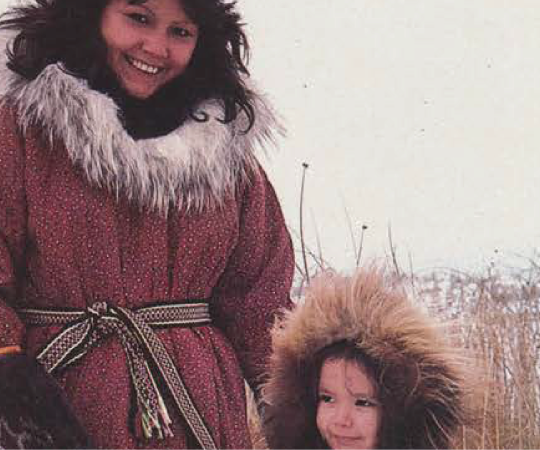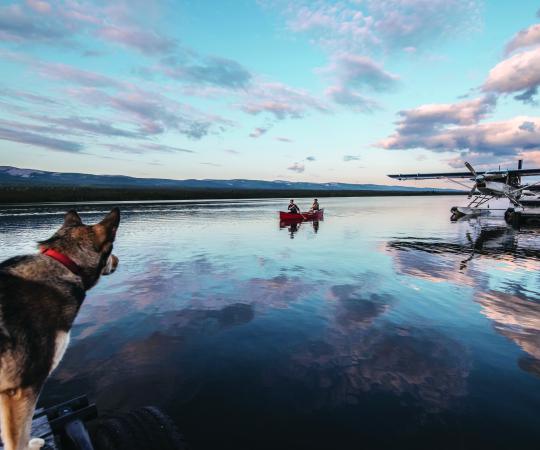The environmentally conscious food writer
Eating local in the North sounds simple: hunt local meat, catch local fish, pick local berries. But what if, like Michele Genest, you can’t really hunt, and you’re the first to admit you’re not the greatest fisherwoman? (No judgment there.) Let’s be clear, we’re talking about the author of two cookbooks—The Boreal Gourmet and The Boreal Feast—that have since become the foundation for modern Yukon gastronomy. There aren’t many commercial fishermen in her hometown of Whitehorse, so how does she conjure up her salmon cheesecakes and poached trout?
“You’re just curing it in sugar and salt, and I’ve been using spruce tips and juniper berries rather than dill [for flavour].”
Luckily there are two fish trucks in town selling fish caught in nearby southeastern Alaska (which, for Whitehorse, counts as local). She can get fresh sockeye from Tlingit fishermen on the Taku River—sometimes even delivered directly to her door—and smoked salmon from local company Taku Wild. But for the most part, she gets her fish from friends, many of whom just want to see what she’ll do with it.
David Curtis of Dawson City is one of them. The visual-artist-turned-fisherman has tried for years to coax locals to eat chum salmon, the slimier and less popular relative of the sockeye, Chinook and coho salmon. But if you clean it well, it’s just as good as any of its brethren. In The Boreal Gourmet, you’ll find a recipe for poached chum salmon. But Genest has since discovered a new favourite. “Gravlax. It’s so easy,” she says. “You’re just curing it in sugar and salt, and I’ve been using spruce tips and juniper berries rather than dill [for flavour].”
And lately, she’s been experimenting with whitefish. Paul Sparling, a commercial fisherman in Marsh Lake, 40 kilometres outside of Whitehorse, catches whitefish in the spring and sells it fresh or frozen in packages of one or five kilograms. Thanks to him, Genest has found a way to pair whitefish with another locally sourced delicacy: morels.
Morel, White Wine and Cream Sauce for Whitefish
INGREDIENTS:
• 8 small to medium dried morels
• 1 1/2 cups (375 mL) boiling water
• 2 cloves garlic, chopped
• 2 Tbsp (30 mL) butter
• 1/2 cup (125 mL) Pinot Grigio
• 2 Tbsp (30 mL) morel mushroom
soaking liquid
• 1–1 1/2 cups (250–375 mL) 35% cream
Pour boiling water over the morels and soak until rehydrated, about half an hour. Gently squeeze out the excess liquid. (Freeze extra liquid for later use in soups or stews.) Slice the morels lengthwise, then crosswise in small pieces. Melt the butter in a sauté pan over medium-low heat, add the garlic, but don’t let it brown. Add morels soon after. Sauté for about 10 minutes.
Turn up the heat to medium, add the wine, stir, and when the bubbling subsides, add the cream. Cook until the cream thickens to the consistency of a thin custard, halfway between a cream soup and a béchamel, about 10 minutes. Makes about 1 1/2 cups (375 mL) sauce. Also works with trout.
[[{"fid":"1613","view_mode":"default","fields":{"format":"default","field_file_image_alt_text[und][0][value]":"Baked trout with morel cream sauce and roasted asparagus. Photo by Amy Lam","field_file_image_title_text[und][0][value]":"Baked trout with morel cream sauce and roasted asparagus. Photo by Amy Lam"},"type":"media","attributes":{"alt":"Baked trout with morel cream sauce and roasted asparagus. Photo by Amy Lam","title":"Baked trout with morel cream sauce and roasted asparagus. Photo by Amy Lam","style":"height: 400px; width: 600px;","class":"media-element file-default"}}]]
The enterprising fish geek
Promoting the very coolness of fish is Janelle Kennedy’s mission. Her real job as senior science advisor in the Government of Nunavut’s Fisheries and Sealing Division mostly involves monitoring fish and seal populations. But she’s also organized events where elders visit local schools and show kids how to carve up fish heads—and how, if you’re really paying attention, you might spot the tulugak, the ookpik or the tuktu leg. That’s because if you squint, certain fish bones look like a raven, an owl or a caribou leg. She’s planning fish cook-offs in communities, and a fish-themed activity book for kids. Last winter, she volunteered to produce a book on the fishes of Nunavut, and at the same time, she’s gathering recipes for a fish and seal cookbook.
Nunavut’s no stranger to cookbooks: the Department of Health has issued volumes encouraging home-cooked meals instead of fast food, and there’s a collection of recipes from popular cooking show host Rebecca Veevee. Usually, Arctic char is the celebrity species, but this latest installment of fish (and seal) recipes has an added focus: cooking with turbot. It’s not a traditional country food, says Kennedy; swimming deeper than 500 metres, turbot are out of reach for traditional technology. Nowadays, most of Nunavut’s turbot is exported, but Kennedy says it’s high time Nunavummiut adopt it into their menus too.
Breaded fried turbot:
INGREDIENTS:
• 3 Tbsp (45 mL) each butter and vegetable oil, or as needed
• One small onion
• 2 small eggs
• 1/2 cup (125 mL) milk
• Black pepper to taste
• 2 cups (500 mL) bread crumbs
• 1 Tbsp (15 mL) celery salt
• 1 Tbsp (15 mL) rosemary
• 1 Tbsp (15 mL) ginger
• 1 Tbsp (15 mL) basil
• 1 Tbsp (15 mL) oregano
• Capers (optional)
• Sweet pickle juice
In a frying pan, heat butter and vegetable oil. Add the onion and stir until it’s translucent. In a small bowl, beat together the eggs and milk, add pepper. On another plate, mix the breadcrumbs and spices. Clean and pat the fish dry. Dip them first into the egg mixture, let drip, then dredge through the breadcrumb mixture. Add to the frying onions. Once the fish is cooked through, add capers, and sprinkle sweet pickle juice on top.
(Recipe courtesy of Lynn Rudd, Rankin Inlet)
The well-seasoned restaurateur
Fish is always one of the daily specials at Yellowknife’s Museum Café. Head chef Chris Zouboules gets most of it fresh from the local processing plant every day and the Arctic char is flown in from Cambridge Bay, Nunavut. He orders it himself, and plans all the menus. Hand him any Northern fish, and he knows exactly what to do with it.
“I don’t understand why people poach whitefish,” he says. “It’s so delicate. If you’re not paying attention, it disintegrates.” With whitefish, you have to know what you’re doing—basically, don’t overseason it. All you really need, he says, is “a little salt, pepper and lemon. That’s it.” When I remind him of that day’s specials, which include blackened whitefish—the memory of which still sizzles on my taste buds—and whitefish soup flavoured with garlic, saffron and anise, he’s unfazed. “I’m at a restaurant,” he explains. In other words, people expect a bit of spice.
“Pickerel [a.k.a. walleye] is the celebrity fish,” he says. But it’s nearly twice as expensive as whitefish, so the restaurant doesn’t get it often. When they do, he calls up his regular patrons to tip them off.
Pike should be more popular, he says. People don’t like it because of the bones—there’s an extra set, known as Y-bones— “but pike is just as good as any other fish if you know how to fillet it. Go simple with that one. Lemon pepper and dill.”
I’m still thinking about that blackened whitefish, but he won’t share his recipe. No way. He does, though, have a potato flake batter you should try at home.
“It’s the one I like best. It’s got a deep-fried finish without actually deep-frying it.” And like all his favourites, it’s down to earth and simple. “You might see this ingredient at the grocery store and think, ‘I can’t believe people buy that,’ but it works,” he says. “It’s also a gluten-free option, for all intents and purposes.”
Potato flake whitefish:
INGREDIENTS:
• 3 whitefish fillets
• 1/3 cup (80 mL) olive oil for frying
• 1/3 cup (80 mL) dry onion flake
• 1 Tbsp (15 mL) lemon pepper
• 1 Tbsp (15 mL) dill
• 2 cups (500 mL) dry potato flakes
Wash fish fillets and place on a paper towel. Mix dried potato flakes with lemon pepper, dill, and onion flakes, and place in a dredging pan.
Pour some of the oil in a frying pan on medium high heat, enough to coat the bottom of the pan when hot. Now dredge your fish. You may have to put a little pressure to coat the fillet and you don’t want to do this too long before the oil is ready for cooking. The potato flakes will become soggy and sticky. Place the fish in the pan and fry until the fish edges become brown and crispy, about four to five minutes. Flip and cook for about three more minutes. Top them with bruschetta or a salsa.
The hobby food photographer
Amy Lam's friends have begged her for years to start a food blog, or compile all her recipes in a book. So far, she's happy with just sharing her food photography and cooking experiments as a hobby, so we were honoured when she agreed to open up her kitchen to us. After hitting up Great Slave Fish Products in Yellowknife, here's what she came up with:
[[{"fid":"1615","view_mode":"default","fields":{"format":"default","field_file_image_alt_text[und][0][value]":"Cranberry rosemary flax crackers with pickled burbot. Recipe and photo by Amy Lam","field_file_image_title_text[und][0][value]":"Cranberry rosemary flax crackers with pickled burbot. Recipe and photo by Amy Lam"},"type":"media","attributes":{"alt":"Cranberry rosemary flax crackers with pickled burbot. Recipe and photo by Amy Lam","title":"Cranberry rosemary flax crackers with pickled burbot. Recipe and photo by Amy Lam","style":"height: 400px; width: 600px;","class":"media-element file-default"}}]]
Cranberry rosemary flax crackers with pickled burbot
Cranberry rosemary flax crackers
1 cup ground flax seeds
¼ cup of whole flax seeds
¼ cup sesame seeds
2 tbsp each: coarsely chopped pumpkin seeds and raw sunflower seeds for a total of 1/4 cup
2 tbsp fresh rosemary, chopped
½ cup of dried unsweetened, wild cranberries
Assembly
Pickled burbot and onions
Chives, chopped
Radishes, thinly slicked
Cranberry rosemary flax crackers: Mix all ingredients in a mixing bowl until a dough forms, adding more water if needed. Split the dough into two balls. Using a rolling pin wrapped in plastic wrap, evenly roll out the dough until 1/16” thick on a teflex dehydrator sheet. Score into triangles with a butter knife. Dehydrate at 115F for 2 hrs, flip, remove teflex sheet and dehydrate for another 6 hrs or until dried. Break into triangles. Can also be baked in a 350F oven for 30 – 35 min.
Assembly: Top each cracker with a piece of pickled burbot and onions and garnish with chives and radishes. In Yellowknife, pickled burbot can be purchased at Luluz Market.
***
[[{"fid":"1616","view_mode":"default","fields":{"format":"default","field_file_image_alt_text[und][0][value]":"Pan fried burbot with lemon, garlic and sage butter sauce. Recipe and photo by Amy Lam","field_file_image_title_text[und][0][value]":"Pan fried burbot with lemon, garlic and sage butter sauce. Recipe and photo by Amy Lam"},"type":"media","attributes":{"alt":"Pan fried burbot with lemon, garlic and sage butter sauce. Recipe and photo by Amy Lam","title":"Pan fried burbot with lemon, garlic and sage butter sauce. Recipe and photo by Amy Lam","style":"height: 400px; width: 600px;","class":"media-element file-default"}}]]
Pan fried burbot with lemon, garlic and sage butter sauce
Lemon, garlic and sage butter sauce
6 large Sage leaves
¼ cup butter + 1 tbsp
1 tbsp parsley, chopped
2 tsp shallots, minced
2 cloves garlic, minced
½ tsp Dijon Mustard
1 tbsp flour
2 tbsp lemon juice
Sea salt
Freshly ground black pepper
Pan fried burbot
4 8oz burbot fillets
Oil for frying
Lemon, garlic and sage butter sauce: In a deep, large skillet melt 1 tablespoon of butter over medium low heat. Fry the sage leaves on both sides until crispy. Remove and set aside on a plate with piece of paper towel. In the same skillet, add the rest of the butter, parsley, shallots, garlic, mustard and lemon juice. Once butter is melted, slowly whisk in butter. Cook for 2-3 min. Remove from heat and crush in the fried sage leaves. Season with salt and pepper.
Pan fried turbot: Heat oil in a skillet over medium-high heat. Season turbot with salt and pepper. Cook 5 minutes on first side. Use a thin metal spatula to carefully turn them over. Continue cooking 2-3 more minutes. Turbot will turn opaque and begin to flake apart when cooked through. Plate fish and top with sage butter sauce.
Adapted from Cinnamon-Spice and Everything Nice
***
[[{"fid":"1614","view_mode":"default","fields":{"format":"default","field_file_image_alt_text[und][0][value]":"Baby greens and herbs salad with smoked trout. Photo and recipe by Amy Lam","field_file_image_title_text[und][0][value]":"Baby greens and herbs salad with smoked trout. Photo and recipe by Amy Lam"},"type":"media","attributes":{"alt":"Baby greens and herbs salad with smoked trout. Photo and recipe by Amy Lam","title":"Baby greens and herbs salad with smoked trout. Photo and recipe by Amy Lam","style":"height: 400px; width: 600px;","class":"media-element file-default"}}]]
Baby greens and herbs salad with smoked trout
Salad
8 – 10 cups of mixed baby greens (arugula, kale, chard, mesclun greens)
1 cup of yellow, red and orange cherry tomatoes, halved
1 cup of loosely packed fresh herbs, chopped (basil, cilantro, chives)
Smoked trout
Dressing
½ cup extra virgin olive oil
2 tbsp apple cider vinegar
1 tbsp of lemon juice
1 shallot, chopped
1 ½ tsp of Dijon mustard
1 tbsp chives, chopped
Sea salt
Freshly ground pepper
Dressing: Mix all ingredients except for salt and pepper in a mason jar. Shake to mix. Season with salt and pepper
Assembly: Mix greens in a large bowl. Toss well with dressing. Top with smoked trout. In Yellowknife, smoked trout can be purchased from Great Slave Fish Products Ltd (aka the fish plant).
***
Baked trout with morel cream sauce and roasted asparagus
Morel cream sauce
8 small to medium dried morels
2 cloves garlic, chopped
2 tbsp butter
½ cup Pinot Grigio
2 tbsp (30 mL) morel mushroom soaking liquid
1 ½ cups (250–375 mL) 35% cream
Baked trout
4 8oz trout fillets
1 lemon, sliced
Olive oil
Roasted asparagus
20 – 24 spears of asparagus, tough ends trimmed
Sea salt
Freshly ground pepper
Olive Oil
Assembly
Lemon wedges
Morel cream sauce: Pour boiling water over the morels and soak until re-hydrated, about half an hour. Gently squeeze out the excess liquid. (Freeze extra liquid for later use in soups or stews.) Slice the morels lengthwise, then crosswise in small pieces. Melt the butter in a sauté pan over medium-low heat, add the garlic, but don’t let it brown. Add morels soon after. Sauté for about 10 minutes. Turn up the heat to medium, add the wine and 2 tbsp of soaking liquid, stir, and when the bubbling subsides, add the cream. Be careful not to let it boil over. Cook until the cream thickens to the consistency of a thin custard, about half-way between a cream soup and a béchamel, about 10 minutes.
Baked trout: Preheat oven to 350F. Lightly brush a shallow baking dish with olive oil, add trout and top with sliced lemons. Baked uncovered for 20 – 25 min.
Roasted asparagus: Preheat oven to 400F. Line a roasting pan with parchment paper or a silpat. Arrange the asparagus spears in a single layer on the lined roasting pan. Drizzle with olive oil and rub the spears all over with the olive oil to coat. Sprinkle with salt, pepper. Roast for 10 minutes or until tender and slightly browned.
Assembly: Plate trout and spoon morel cream sauce on top, serve with asparagus and fresh lemon wedges.
Adapted from the The Boreal Gourmet










